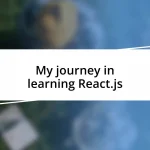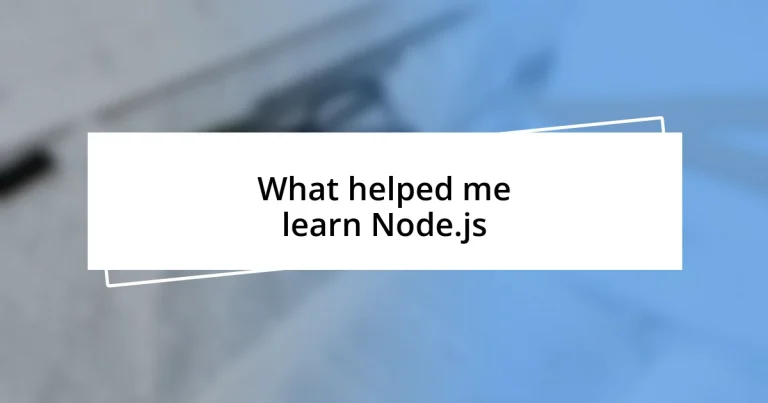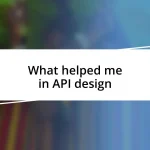Key takeaways:
- Initial excitement for Node.js stemmed from the ability to use JavaScript on both the front-end and server-side, driving the author’s motivation to learn.
- Engaging in hands-on projects and utilizing diverse learning resources, such as online courses and community forums, enriched the learning experience and made concepts more tangible.
- Overcoming challenges, like asynchronous programming and debugging, was achieved through persistence, community support, and structured goal setting, ultimately enhancing the author’s coding journey.
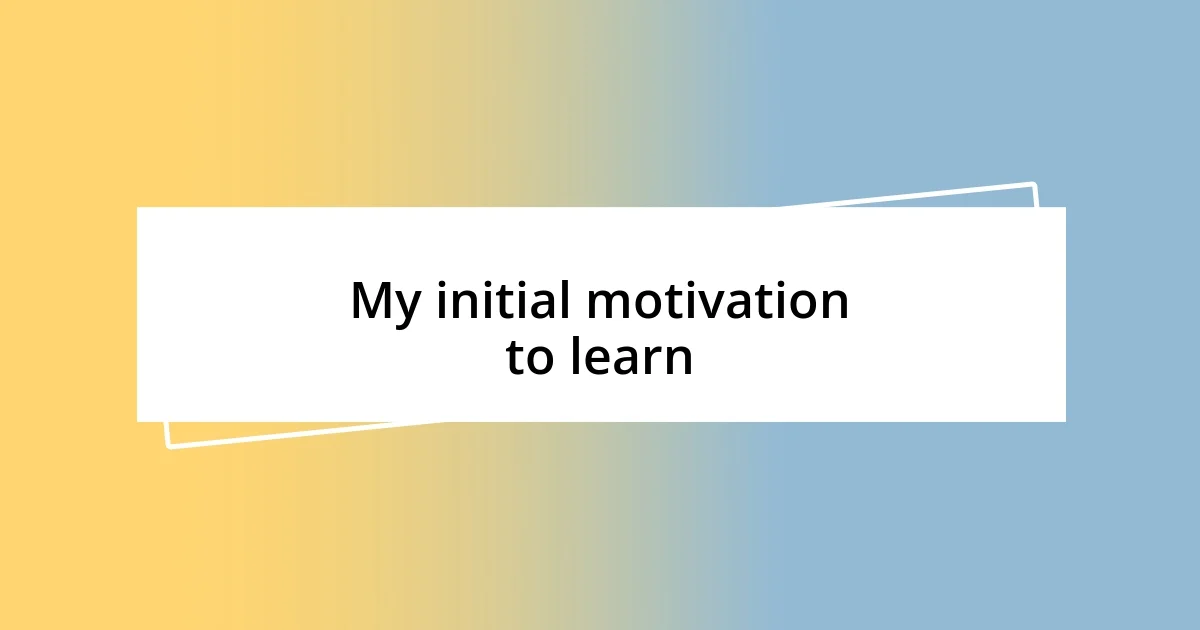
My initial motivation to learn
When I first heard about Node.js at a tech meetup, my interest piqued instantly. I was captivated by the idea of using JavaScript—something I loved for front-end development—on the server side. How cool was it to bridge my favorite programming language across both ends of web applications?
I remember the excitement of building my first real-time chat application with Node.js. The joy of seeing messages sent and received instantly was exhilarating. I felt like a wizard, conjuring up functionalities that could connect people in real-time, and that sense of accomplishment was addictive.
Besides the thrill of creating, I was motivated by my desire to stay relevant in the ever-evolving tech landscape. I often asked myself, “What’s next for me in my coding journey?” Learning Node.js felt like a natural evolution, a step towards expanding my skills and embracing new challenges that could open doors to exciting projects and job opportunities.

Choosing the right resources
Choosing the right resources can significantly impact your learning journey. I remember hunting for materials that resonated with my learning style. A mix of videos, articles, and hands-on projects kept me engaged. This variety not only solidified my understanding but also made the experience enjoyable.
Here’s what I found helpful when selecting resources for learning Node.js:
- Online Courses: Find ones that offer practical projects that align with your interests.
- YouTube Tutorials: Look for developers who explain concepts in relatable ways; I found this a game changer.
- Documentation: The official Node.js docs are invaluable for a deeper understanding.
- Books: A well-structured book can be a great companion; I still refer back to mine.
- Community Forums: Engaging with others on platforms like Stack Overflow provided real-world insights and support.
Ultimately, the right resources will empower you to learn effectively and enjoy the process, making your Node.js adventure a fulfilling one.

Best online courses reviewed
When it comes to online courses for Node.js, I found a few that really stood out in my learning experience. One that I particularly enjoyed was a course that emphasized hands-on projects right from the start. Creating something tangible made the concepts much more memorable, and I still remember the thrill of debugging problems in the code; it felt like solving little mysteries!
Another course I explored had a vibrant community forum where learners shared their projects and challenges. Engaging with others not only provided immediate feedback but also inspired innovative ideas. I often found myself tackling challenges posed by fellow students, which made learning Node.js a collaborative and dynamic experience.
To give you a clearer picture of what these courses offer, here’s a comparison table of some of the best online options available:
| Course Name | Focus |
|---|---|
| The Complete Node.js Developer Course | Hands-on projects |
| Node.js: The Complete Guide to Building APIs | API development |
| Learn Node.js by Building 10 Projects | Practical applications |
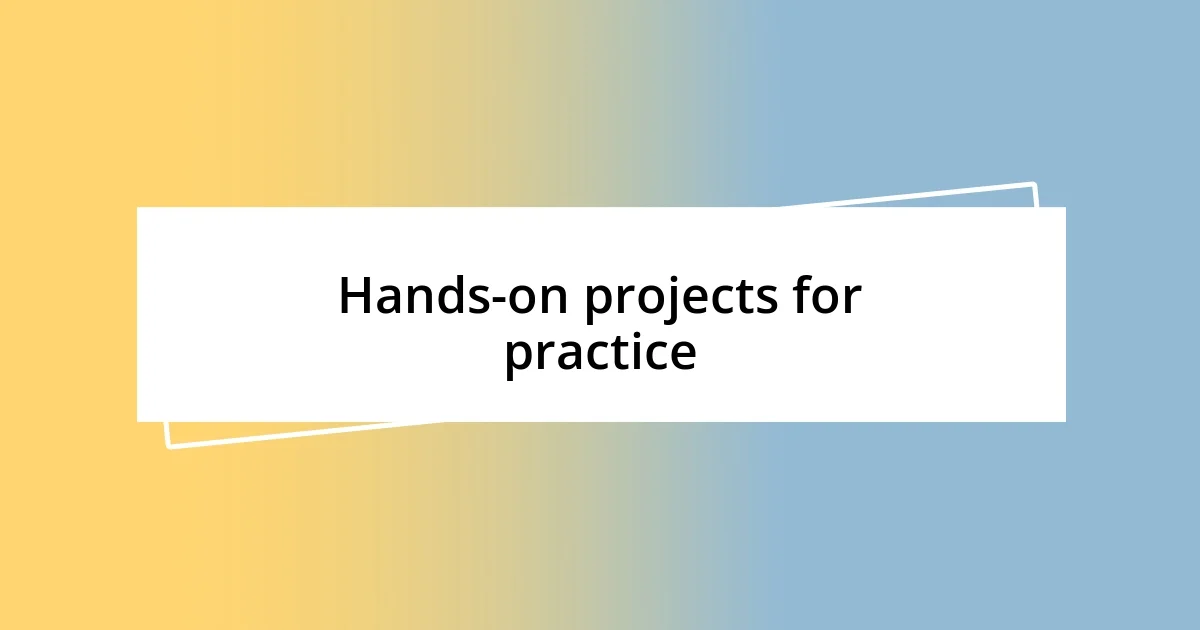
Hands-on projects for practice
Diving into hands-on projects was a game changer for me. I recall spending weekends building a simple RESTful API—it felt exhilarating to see my ideas come to life. The moment I hit “send” in Postman and saw my application respond correctly, I couldn’t help but smile. Isn’t it satisfying when the code you write actually works the way you envisioned?
One memorable project was crafting a small chat application using Socket.io. As I integrated real-time messaging, I found myself fully immersed in problem-solving; every bug felt like a challenge I was determined to conquer. There was something magical about watching the messages appear instantly on the screen. How rewarding it is to create something functional out of mere lines of code!
I also experimented with building a task tracker app that helped me manage my day-to-day tasks. As I worked through user authentication and database integration, I often caught myself thinking, “This could help me in my own life.” This connection between learning and real-world application motivated me to push through the tough spots. Hands-on projects are not just learning experiences; they’re opportunities to see how coding can enhance our daily routines.
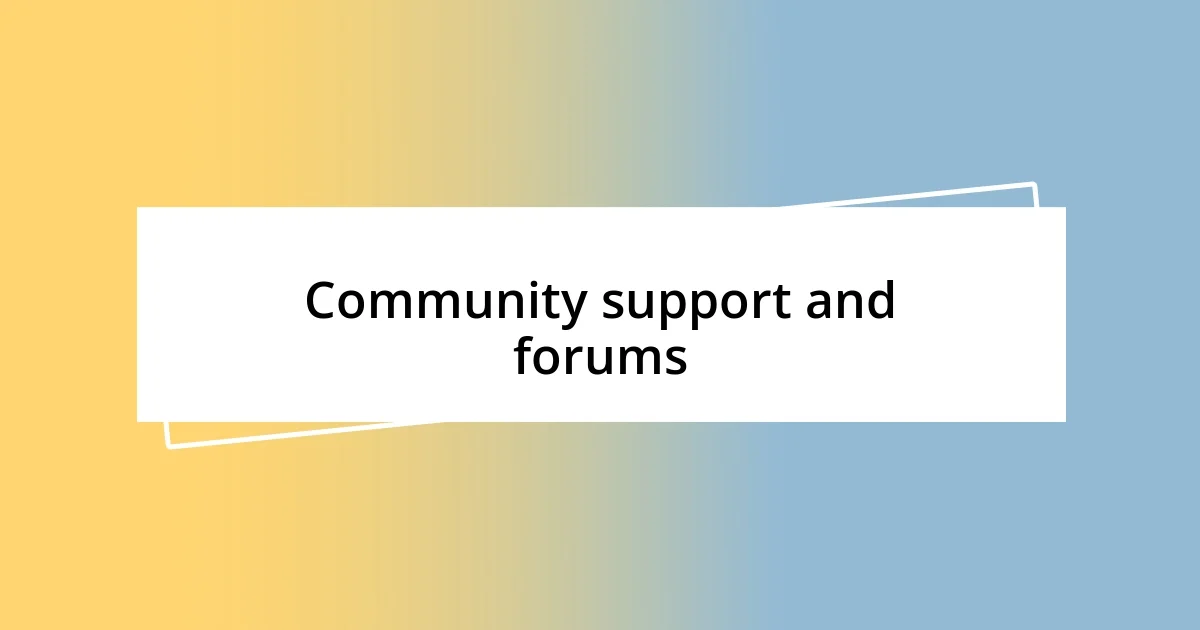
Community support and forums
I can’t stress enough how valuable community support has been in my journey with Node.js. There were days when I felt utterly lost in the code, but a simple post on a forum often brought the clarity I needed. I remember a specific instance when I struggled with asynchronous programming; a kind developer not only answered my question but also provided a code snippet that opened my eyes to new possibilities. Hasn’t it happened to you that just a little guidance can steer you in the right direction?
Engaging in forums became my virtual classroom, where lessons went beyond the curriculum. I found it incredibly motivating to read about other developers’ triumphs and challenges. One night, while exploring a thread about real-time WebSocket implementation, I couldn’t help but think how generous people are in sharing their knowledge. It was like a light bulb moment, illuminating the path ahead and encouraging me to experiment with my projects. Isn’t that sense of camaraderie amazing?
From my experience, being an active participant in the community allows for continuous learning. I recall how sharing my own project led to constructive criticism that refined my coding techniques. This two-way street of knowledge not only bolstered my confidence but also helped cultivate friendships with fellow learners. It really made me appreciate how powerful and essential community engagement is in the tech world. Don’t you feel that collective growth is one of the most enriching aspects of learning?
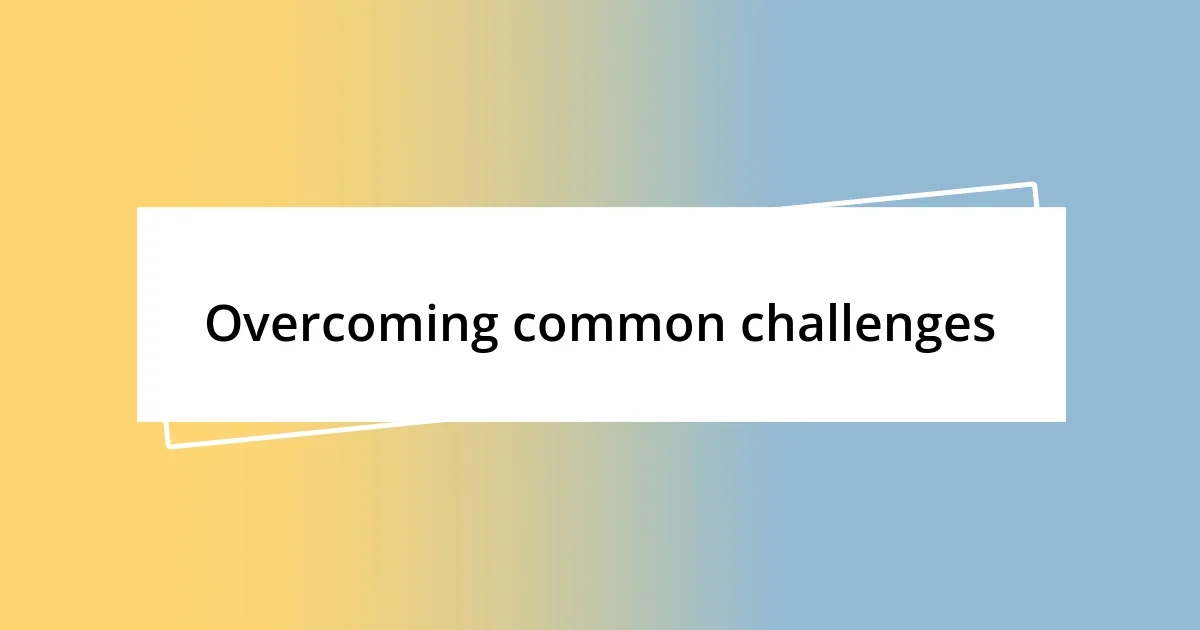
Overcoming common challenges
I faced several challenges while learning Node.js, particularly with understanding the intricacies of asynchronous programming. I vividly recall a night spent staring at my screen, feeling completely overwhelmed by callbacks and promises. I eventually had that “aha” moment when I realized that visualizing the call stack helped me grasp what was happening behind the scenes. Have you ever found that sometimes stepping back and visualizing a problem can make all the difference?
Another hurdle was managing dependencies. I often experienced frustration when modules I needed simply weren’t playing nice with each other. One time, I spent hours trying to solve a version conflict with Express. I remember the relief flooding over me when I finally figured out how to use npm to manage my packages effectively. Isn’t it fascinating how a single command can save you countless hours of headache?
Debugging was also a challenge that tested my patience. Early on, I experienced the sheer agony of encountering cryptic error messages. I can still picture sitting at my desk, questioning if I had chosen the right path at all. Over time, I developed a habit of methodically digging into the issues rather than panicking. Each resolved error taught me valuable lessons, turning what once felt like a chore into a rewarding puzzle. Doesn’t overcoming those frustrating moments feel like striking gold?
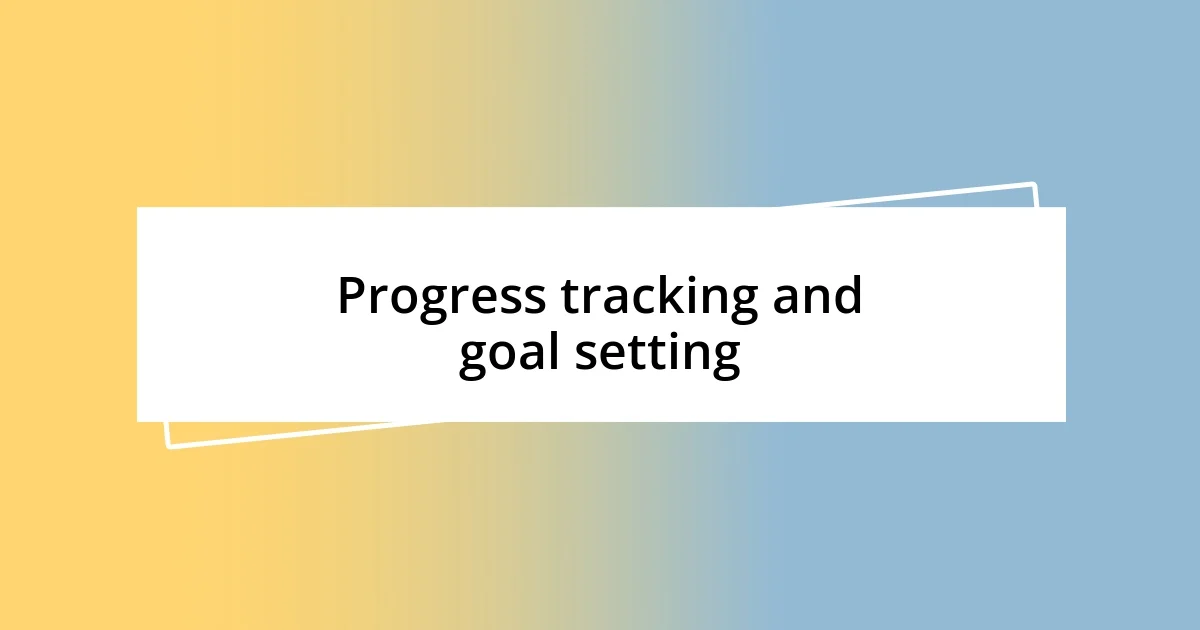
Progress tracking and goal setting
Tracking progress while learning Node.js was a game-changer for me. I started with a simple checklist, setting small, achievable goals each week. The satisfaction of ticking off tasks not only fueled my motivation but also provided a clear sense of direction. Have you ever felt that rush of accomplishment from reaching a milestone?
I also kept a learning journal to document my journey. Reflecting on my experiences and setbacks allowed me to recognize patterns in my understanding. In moments when I felt stuck, flipping back through those pages reminded me of how far I’d come. It’s incredible how a tangible record of your growth can lift your spirits when learning feels overwhelming, don’t you think?
Setting specific goals enabled me to break down complex topics into manageable chunks. For instance, when tackling the concept of middleware, I aimed to understand one function each day. This approach transformed a daunting subject into a systematic adventure. It taught me that celebrating small victories can invigorate my entire learning experience. Have you found that setting milestones makes the journey feel less like a marathon and more like a series of exciting sprints?
